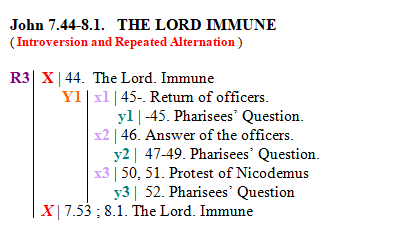Diserner
Active Member
This section is only in one early edition of John (codex D).
Some later manuscripts place it John 7:36, 7:44, or at the end of the work.
Origen and Tertullian skip over it in context, and it's first mentioned by Jerome.
Four distinct later manuscripts place it after Luke 21:38.
It clearly breaks the flow of discourse and narrative in John at the place it was inserted:
https://caffeinatedtheologian.wordpress.com/2015/01/17/on-the-inspiration-of-the-pericope-adulterae/ writes:
I would add also, that the Synoptics record the cycle of attacks by the Pharisees where they are specifically looking to trap Jesus in his words, which story perfectly fits this later theme, and where there is the specific mention of Jesus coming in the mornings near the temple area that is not mentioned in John (Mat. 21:18; Mark 11:20; Luke 21:38).
I think all of this evidence is very strong.
Some later manuscripts place it John 7:36, 7:44, or at the end of the work.
Origen and Tertullian skip over it in context, and it's first mentioned by Jerome.
Four distinct later manuscripts place it after Luke 21:38.
It clearly breaks the flow of discourse and narrative in John at the place it was inserted:
https://caffeinatedtheologian.wordpress.com/2015/01/17/on-the-inspiration-of-the-pericope-adulterae/ writes:
The problem with the placement of the text has led some theologians to believe that the periscope adulterae could be of Lucan origin.
Henry Cadbury, an advocate of the Lucan authorship of the periscope adulterae, concluded that the vocabulary and style employed by the periscope is more characteristic of Luke than John.[4] Cadbury identifies vocabulary used in the periscope adulterae that occurs in Luke and Acts but no other New Testament work.[5] Fausto Salvoni highlights the fact that the same author would not likely have used these two distinct writing styles.[6] Salvoni identifies several reasons why the periscope adulterae could possibly be Lucan in origin, and not original to the Gospel of John.
Within his writing, Luke had a tendency to emphasize the individual. He consistently focused on women, social outcasts, children and the poor. Furthermore, Luke emphasized the role of women in Jesus’ ministry significantly more than any other gospel writer. Several stories involving women are found solely in the gospel of Luke including the women who followed Jesus (8:1-3), the resurrection of the son of the widow (7:11-17) and the sinner woman whom Jesus forgave (7:36-50).[7] Finally, in John’s gospel, he consistently takes time to discuss the theological impact of Jesus’ actions, which the author of the pericope adulterae does not take time to do. In his work, Behind the Third Gospel, Vincent Taylor argues for “Proto-Luke” writings. He supposes that Luke’s career as a historian led him to collect oral material and eye-witness accounts, especially those that focused on women, that he would later use in his writings.[8] According to Taylor, there must have been some material that remained unused in the composition of the books of Luke and Acts. Therefore, the Gospel writers and church patriarchs would have had this “Proto-Luke” collection of writings to draw from. The story of the adulterous woman could have been a well-known passage in the early church, written by Luke, and later inserted into the Gospel of John. Though the idea of Lucan authorship is solely a supposition, it supplies a solid argument for the origin of the pericope adulterae.
[4]Cadbury, Henry. “A Possible Case of Lucan Authorship (John 7:53-8:11).” The Harvard Theological Review (Cambridge University Press) 10, no. 3 (July 1927): 237-244.
[5]Ibid., 239.
[6]McMillan, Textual Authority, 18.
[7]Ibid., 20.
[8]Taylor, Vincent. Behind the Third Gospel: A Study of the Proto-Luke Hypothesis. Clarendon Press, 1926.
I would add also, that the Synoptics record the cycle of attacks by the Pharisees where they are specifically looking to trap Jesus in his words, which story perfectly fits this later theme, and where there is the specific mention of Jesus coming in the mornings near the temple area that is not mentioned in John (Mat. 21:18; Mark 11:20; Luke 21:38).
I think all of this evidence is very strong.

